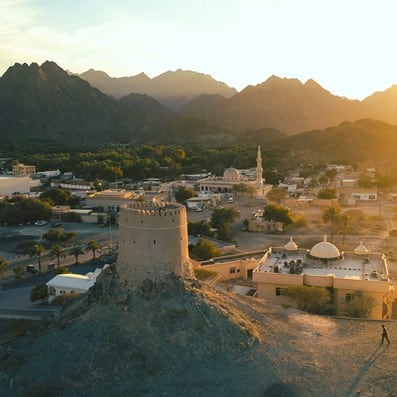History & Heritage
Discover Hatta's rich history
Tue 10 September 2024
Journey decades back to an era of citadels, forts and towers in Dubai's mountain town.
Journey decades back to an era of citadels, forts and towers in Dubai's mountain town.
Natural paradise

Located nearly 130km southeast of central Dubai, Hatta's craggy mountains, scattered springs and lush valleys offer a stark contrast to the glassy facades of the city. Hike up the Hajar mountains and you will encounter breathtaking views of the historical village. The area was once called Al Hajerin, or Al Hajeran, in reference to the two mountain peaks guarding its north and south borders. A fertile land, its favourable climate and falaj – ancient irrigation systems – once nurtured thriving agricultural and farming communities.
Get familiar with the life of ancient villagers who depended on the cultivation of palm trees and dates for their livelihood. These low cost, desert-dwelling trees were enough to sustain daily life; dates would be harvested for domestic consumption or dried and sold. Palm leaves were woven into mats, fans and carpets, while tree trunks were used to construct tents and houses.
Farming continues to be a major activity in Hatta and, today, more than 550 farms operate across the nearly 140sqkm area, representing 10 per cent of the land. While local heritage lives on through small farms within the village, the future is protected at new bird and animal conservation areas. Visitors can even step into the shoes – and protective gear – of a beekeeper for a day at Hatta Honey Bee Discovery Centre.
Water wonder

In the past, due to rainwater scarcity, residents had to depend on groundwater wells and springs. But following the construction of dams, water is available all year round in the wadis, or valleys, cradled by the mountains. These are replenished by rainwater in winter, breathing new life into the gorge, where flora and fauna claim the land.
The landmark Hatta Dam was constructed in the late 1990s, and the reservoir took two years to fill. It brought much-needed respite to Hatta’s residents, giving them access to a sustainable water supply. Hatta Dam is now one of the main attractions in the area, with the bright, turquoise water set against the earthy rock for a picturesque vista. Visitors can drive along the dam and stop at viewpoints for photographs, or trek across it and down the hilly terrain. For a closer look, kayak across the quiet lake formed by the dam, bringing you into the heart of the panorama.
Flanked by the mountains, Hatta enjoys a cooler climate than its coastal counterparts. The summits of the Hajar mountains reach 800 to 1,600m and were first formed under the seabed in ancient times. Their imposing presence includes beautiful rock formations and crevices, sculpted by years of geological activity.
Village life

In the heart of the town is Hatta Heritage Village, which has been preserved and reconstructed by the government to showcase rural living dating back centuries. Opened in 2001, the village brings to life Dubai’s heritage, with reconstructed huts and buildings selling traditional wares. The village also houses life-size prototypes, documents and sculptures.
Located within Heritage Village is Bait Al Wali, one of the largest houses, where the ruler used to reside. Wander through its many rooms and courtyard before pausing at a shaded seating area. Outside, the villagers carry on inherited traditions of making jewellery, weaponry, pottery and utensils using clay, leather and copper that's been mined from the mountains. You can even get familiar with social customs such as wedding rituals, folklore, games and traditional songs here – it's an ideal afternoon getaway from the city.
Forts and citadels

Explore the central Hatta Fort, built in 1896, and one of the most significant architectural monuments in the UAE. The detailed structure served as a residence and defence facility with a large internal courtyard and an 11m-high watchtower. The building, which was restored in 1995, is made of mountain stones and mud bricks, while the ceiling is constructed using palm fronds, trunks and mud.
The two round watchtowers overlooking the mountain village were built in the 1880s. They are located 2.5m above ground level with a small door and semi-circular staircase leading to the roof. Guards would use ropes to scale the towers and enter through the doors.
A short walk from the village is the palm tree farm known as the Al Sharia site. Take a tranquil walk under the trees and explore the falaj irrigation system that extends several kilometres under ground before appearing on the surface.
Near the village is Hatta Hill Park, built in 2004. The serene area is popular for picnics and barbecues, as well as a tower, which makes for an excellent vantage point.






